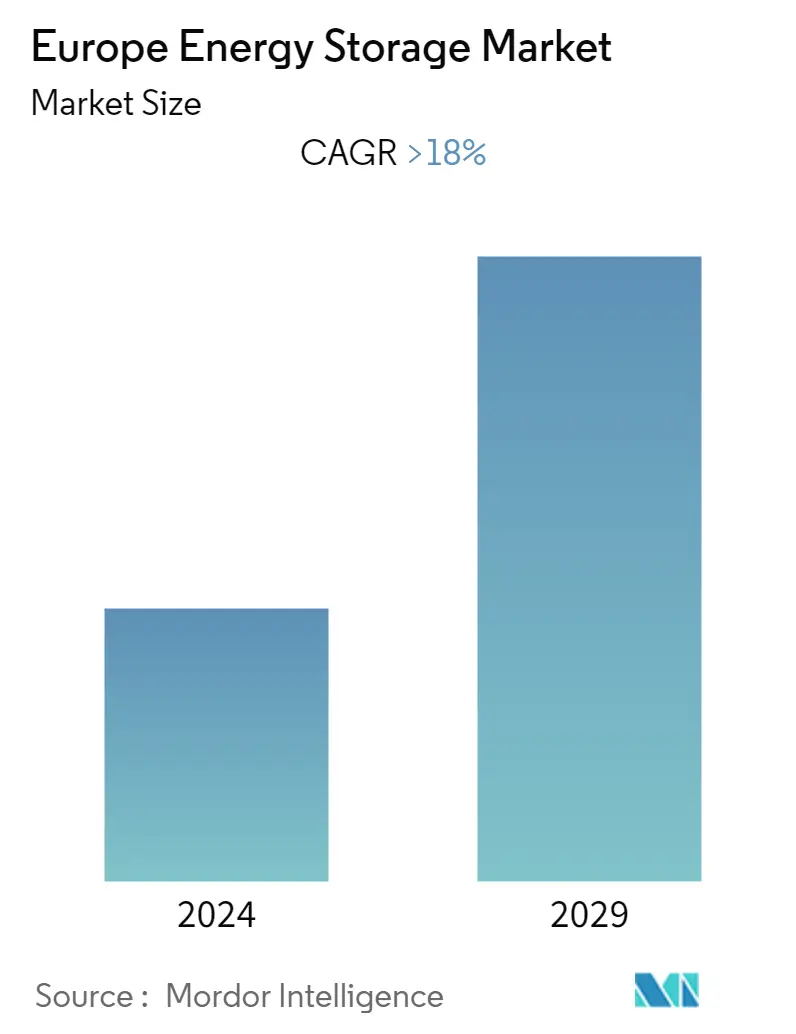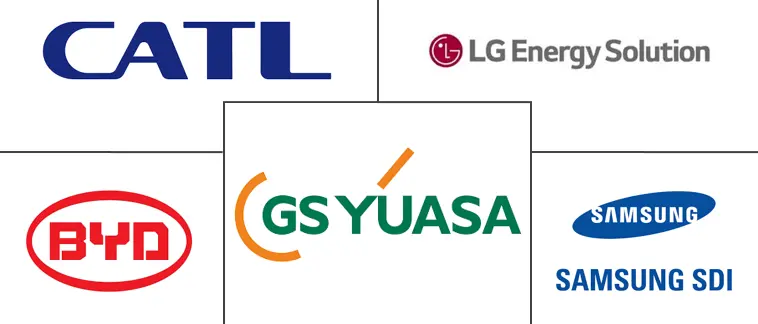Market Size of Europe Energy Storage Industry

| Study Period | 2020 - 2029 |
| Base Year For Estimation | 2023 |
| Forecast Data Period | 2024 - 2029 |
| Historical Data Period | 2020 - 2022 |
| CAGR | 18.00 % |
| Market Concentration | Medium |
Major Players
*Disclaimer: Major Players sorted in no particular order |
Europe Energy Storage Market Analysis
The Europe energy storage market is expected to grow at a CAGR of 18 % during the forecast period.
The market was negatively impacted by COVID-19 in 2020. Presently the market has reached pre-pandemic levels.
- Over the long term, factors like increasing demand for uninterrupted power supply and decreasing price of lithium-ion batteries are expected to drive the market.
- On the other hand, a mismatch in the supply and demand of raw materials is a significant restraint hindering the market's growth.
- Nevertheless, the increasing technological advancements in various technologies like compressed air energy storage (CAES), which has higher efficiency than present-day technologies, are expected to create enormous opportunities for the Europe Energy Storage Market.
- Germany is expected to dominate the market during the forecast period, owing to the increasing energy demand from residential, industrial, and commercial sectors and supportive government policies.
Europe Energy Storage Industry Segmentation
An Energy Storage System, often abbreviated as ESS, is a storage system that captures energy produced at one time from any energy-producing source for use at a later time as per the convenience of the end user to reduce imbalances between energy demand and energy production. The quantity of energy and power defines an Energy Storage System (ESS) it is capable of storing (MWh and MW).
Technology, End-User, and Geography segment the Europe energy storage market. By Technology, the market is segmented into Batteries, Pumped-Storage Hydroelectricity (PSH), Thermal Energy Storage (TES), Flywheel Energy Storage (FES), and Others. By End-User, the market is segmented into Residential and Commercial & Industrial. The report also covers the market size and forecasts for the Europe energy storage market across major countries. For each segment, the market sizing and forecasts have been done based on revenue (USD billion).
| Technology | |
| Batteries | |
| Pumped-Storage Hydroelectricity (PSH) | |
| Thermal Energy Storage (TES) | |
| Fywheel Energy Storage (FES) | |
| Others |
| End-User | |
| Residential | |
| Commercial & Indsutrial |
| Geography {Market Size and Demand Forecast till 2028 (for regions only)} | |
| Germany | |
| United Kingdom | |
| France | |
| Italy | |
| Austria | |
| Switzerland | |
| Rest of Europe |
Europe Energy Storage Market Size Summary
The Europe energy storage market is poised for significant growth, driven by the increasing demand for reliable power supply and the declining costs of lithium-ion batteries. The market, which experienced a downturn due to the COVID-19 pandemic, has rebounded to pre-pandemic levels. Technological advancements in energy storage solutions, such as compressed air energy storage, are expected to create substantial opportunities. However, challenges such as the mismatch in the supply and demand of raw materials pose constraints to market expansion. Germany is anticipated to lead the market, supported by rising energy demands across various sectors and favorable government policies. The integration of battery energy storage systems with renewable energy sources is crucial for enhancing grid stability and supporting the transition to a sustainable energy system.
Battery energy storage systems are integral to Europe's energy transformation, facilitating the integration of renewable energy and improving power utilization efficiency. The region has seen a significant increase in renewable energy capacity, driven by climate mitigation policies and the need to reduce dependence on Russian natural gas imports. Countries like Germany, the Netherlands, and Portugal are accelerating their renewable energy targets, thereby boosting the demand for battery energy storage systems. The market is moderately fragmented, with key players including GS Yuasa Corporation, Contemporary Amperex Technology Co. Limited, BYD Co. Ltd, LG Energy Solution, Ltd., and Samsung SDI Co. Ltd. Notable projects, such as the deployment of large-scale battery energy storage systems in France and Germany, underscore the growing importance of energy storage in supporting the region's energy transition goals.
Europe Energy Storage Market Size - Table of Contents
-
1. MARKET OVERVIEW
-
1.1 Introduction
-
1.2 Market Size and Demand Forecast, in USD billion, till 2028
-
1.3 Recent Trends and Developments
-
1.4 Government Policies and Regulations
-
1.5 Market Dynamics
-
1.5.1 Drivers
-
1.5.2 Restraints
-
-
1.6 Supply Chain Analysis
-
1.7 Porter's Five Forces Analysis
-
1.7.1 Bargaining Power of Suppliers
-
1.7.2 Bargaining Power of Consumers
-
1.7.3 Threat of New Entrants
-
1.7.4 Threat of Substitutes Products and Services
-
1.7.5 Intensity of Competitive Rivalry
-
-
-
2. MARKET SEGMENTATION
-
2.1 Technology
-
2.1.1 Batteries
-
2.1.2 Pumped-Storage Hydroelectricity (PSH)
-
2.1.3 Thermal Energy Storage (TES)
-
2.1.4 Fywheel Energy Storage (FES)
-
2.1.5 Others
-
-
2.2 End-User
-
2.2.1 Residential
-
2.2.2 Commercial & Indsutrial
-
-
2.3 Geography {Market Size and Demand Forecast till 2028 (for regions only)}
-
2.3.1 Germany
-
2.3.2 United Kingdom
-
2.3.3 France
-
2.3.4 Italy
-
2.3.5 Austria
-
2.3.6 Switzerland
-
2.3.7 Rest of Europe
-
-
Europe Energy Storage Market Size FAQs
What is the current Europe Energy Storage Market size?
The Europe Energy Storage Market is projected to register a CAGR of greater than 18% during the forecast period (2024-2029)
Who are the key players in Europe Energy Storage Market?
BYD Co. Ltd, Samsung SDI Co. Ltd, GS Yuasa Corporation, Contemporary Amperex Technology Co. Limited and LG Energy Solution, Ltd. are the major companies operating in the Europe Energy Storage Market.

